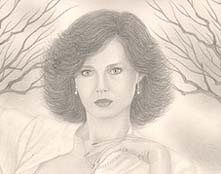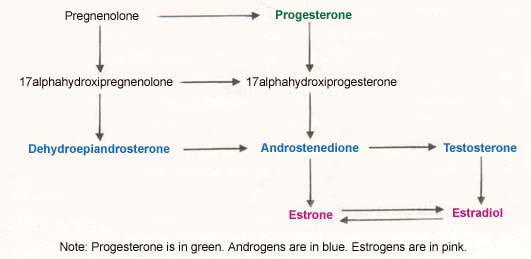|
The
Curious Relations Between Androgens and Estrogens in Women ( Adapted
excerpt from "Os Órgãos
Sexuais Femininos" )
|
 |
The purpose
of this article is to introduce and comment some aspects of the very curious
relations existing between male and female hormones in the female sex.
As I have observed in my book "Os Órgãos
Sexuais Femininos: Forma, Função, Símbolo e Arquétipo"
("The Female Sexual Organs: Shape, Function,
Symbol and Archetype"), in women, due to an intriguing
biochemical peculiarity, the female hormones ( estrogens ) are produced
having male hormones ( androgens ) as precursors. In a way, we can regard
this physiological event as being somewhat "problematic" for
women, since it is one of the factors responsible for the phenomenon of
follicular atresia or death. From early childhood up to the age of 50,
follicular atresia is the main cause for the depletion of the ovarian
follicular population that finally culminates with menopause.
The fact that the estrogens are produced by the ovaries having androgens as precursors obliges women to first produce male hormones in order to subsequently transform them into female ones. As I have already said, this biochemical peculiarity seems to be an important cause for the atresia ( death ) of the great majority of the ovarian follicles that begin their growth, leading, over the years, to the complete ovarian depletion about the age of 50. In the ovarian follicles, the accumulation of androgens produced by the theca cells when they are not adequately turned into estrogens by the granulosa cells seems to exert an inhibiting effect upon the follicular structures, causing the follicles to become atretic and die ( Note 1 ). Now, let us see the main stages of the sexual hormones synthesis in the ovaries:
|
As we can verify,
the first important sexual steroid that is formed is progesterone. The
androgens ( dehydroepiandrosterone, androstenedione and testosterone )
arise in an intermediate stage, while the estrogens ( estrone and estradiol
) only make their appearance at the final one. The estrogens are formed
directly from the androgens, that is, the androgens androstenedione and
testosterone are directly turned into the estrogens estrone and estradiol.
The relations
between the respective biological potency of the androgens and estrogens
involved in this complex biosynthetic chain and the positions they occupy
in it are also very important here. Dehydroepiandrosterone is an androgen
that possesses a very low biological potency. Androstenedione, which is
the immediate precursor of testosterone, has 20 percent of testosterone's
potency. Testosterone is the most important androgen produced by the ovaries
( Note 2 ). Thus, we can verify that the biosynthesis of the male hormones
follows an increasing order of biological potency and activity. Nevertheless,
the estrogens that arise immediately afterwards ( estrone and estradiol
) are already endowed with an enormous biological potency. Comparing their
respective biological activity, we will see that estrone and estradiol
are much more potent than their precursors androstenedione and testosterone
( Note 3 ).
It is easy
to understand why estrogens are so potent. Since the ovaries do not suceed
in transforming a considerable part of androstenedione and testosterone
into estrone and estradiol, this very high biological potency of the estrogens
becomes a biological need of women. We can say so because the female nature
has to defend herself against the risk of an insufficient transformation
of androgens into estrogens. Regarding this, another women's "defense
mechanism" lies in the capability their fatty tissue has of performing
the peripheral transformation of the androgen androstenedione into the
estrogen estrone. Because of this, a variable part of the estrone produced
in women's bodies does not come from the ovaries but from their fatty
tissue. Therefore, the fatty tissue contained in the female body plays
an important role in women's endocrine physiology, and this is one more
reason for advising them to keep their weight within the normal ( Note
4 ).
As to our main subject, philosophically
we can say that, at the exclusively hormonal level, the estrogens are the
main endocrine manifestation of the female principle, and the androgens
the main endocrine manifestation of the male one. In this way, there are
indications that, in women, the complete endocrine manifestation of the
female principle that characterizes them as women depends, paradoxically,
on a subtle endocrine manifestation of the male principle.
From the standpoint of archetypal
psychology, perhaps the fact that the estrogens are produced having androgens
as precursors may also be one of the explanations for the old mythological
idea according to which women would have been created from men.
Note 1: In
the growing ovarian follicles the estrogen synthesis occurs in two basic
stages, the first one taking place in the theca cells and the second in
the granulosa cells. The androgens are produced by the theca cells under
the LH ( luteinizing hormone ) stimulation. The granulosa cells, under
the FSH ( follicle stimulating hormone ) stimulation, turn the androgens
produced by the theca cells into estrogens. ( Each growing ovarian follicle
consists of an oocyte surrounded by several layers of granulosa and theca
cells that proliferate around it and produce the sexual hormones. )
Note 2: There is a peripheral
transformation of androstenedione and testosterone into another androgen,
which is dihydrotestosterone. This transformation takes place in the tissues
sensitive to the male hormones. Dihydrotestosterone is the most potent of
all androgens and the one that really stimulates the majority of the androgen-receptors
in women's and men's bodies. As both in women and men dihydrotestosterone
is an exclusive result of peripheral transformation, there is no gonadic
and adrenal secretion of this androgen.
Note 3: We must remember that
there is a weak estrogen circulating in the female organism, estriol. Nevertheless,
estriol already is a final product of the estrogen metabolism.
Note 4: On the other hand, the
typical distribution of the subcutaneous fatty tissue along the woman's
body is due to the estrogens, and is a very important female sexual feature.
As to women's fatty tissue, there are also some recent studies trying to
establish a correlation between the age of menarche and the percentage of
this tissue in the adolescent's body. Nelson Soucasaux is a gynecologist dedicated to
Clinical, Preventive and Psychosomatic Gynecology. Graduated in 1974 by
Faculdade de Medicina da Universidade Federal do Rio de Janeiro, he is
the author of several articles published in medical journals and of the
books "Novas Perspectivas em Ginecologia"
("New Perspectives in Gynecology") and "Os
Órgãos Sexuais Femininos: Forma, Função, Símbolo
e Arquétipo" ("The Female Sexual Organs: Shape, Function,
Symbol and Archetype"), published by Imago Editora, Rio
de Janeiro, 1990, 1993.
![]()
![]()
![]()
[ Home ] [ Consultório
(Medical Office) ] [ Obras Publicadas
(Published Works) ]
[ Novas Perspectivas em Ginecologia (New Perspectives
in Gynecology) ]
[ Órgãos Sexuais Femininos (The
Female Sexual Organs) ]
[ Temas Polêmicos (Polemical Subjects)
] [ Tópicos Diversos (Other
Topics)(Part 1) ]
[ Tópicos Diversos (Other
Topics)(Part 2) ] [ Ilustrações
(Illustrations) ]
![]()
